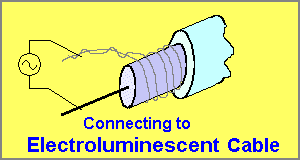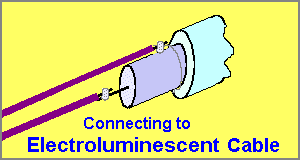ELECTROLUMINESCENCE
THEORY
Connecting leads to Electroluminescent cable is a delicate operation.
The end must be prepared very carefully to prevent fine wires being broken and
soldering takes a certain amount of skill.
PREPARING
THE ENDS OF EL WIRE
If the two
connecting wires are joined together (this is called figure-8 flex or figure-8
wire), the connection
will be very strong as the centre wire is very thick and will resist a small
amount of "tugging." However, if the two connecting wires are
separate, you must be careful to heat-shrink the joint or join the two
connecting wires together so that the outer connection cannot be pulled from
its "safe" position. The two solder points cannot be allowed
to come close to each other as the voltage will "flash over" and
create a low resistance path.
Connecting
wires to EL cable
![]()
EL Cable has two conductors. An inner and outer conductor or
wire. The outer conducting wire is actually two very fine wires.
These must be twisted together to form a single wire. The inner conductor is
the thick centre wire. After soldering to these wires, they must be kept
separated and insulated from each other. The wiring should also be insulated
from the outside environs to prevent
accidental contact and also prevent moisture getting into (and onto) the active
substrate.

Connecting and AC voltage to the EL Cable
Only one end of a length of Electroluminescent cable needs to be prepared for
connecting the supply voltage. The other end is called the "But-end"
or "dead-end" and must be terminated with a cap or
sealed with silicon sealant to prevent moisture "wicking" up the
tubing and damaging the phosphors. You must also check the "but-end"
(the "cut-off" end) before sealing to make sure the fine outer wires do not touch
the inner wire (or are not near it) as the voltage can form a "trace" across the
conducting materials and create a path that will "kill" the operation
of the cable. Seal the end and you
are ready to work on the "active" end.
To prepare the "active" end, the outer "sheath" must be
removed to expose two fine wires. This can be done with
sharp side-cutters or a blade. By cutting carefully around the outer layer, it
can be slid off. Remove about 1.5cm (1/2inch).
To cut the outer layer without damaging the inner layers, the tubing can be bent
slightly and cut at the same time.
Stripping tools are also available for the job and are an advantage if a large
number of ends need to be prepared.
The fine wires are unwound and twisted together.
Next, the inner wire needs to be exposed. Cut the inner tubing at the 0.5cm mark
and slide it off the inner wire.
The inner wire must now be cleaned and scraped with a blade to expose the metal.
When this is done, the two conductors can be tinned, ready for the power
leads.
When soldering wires to the EL cable, it is important to stagger the
connections, so that they never touch.
Solder to the inner wire first, then make sure the outer connection is away from
the first connection.
You can complete the joint by sliding a length of heat-shrink tubing over the
connections and shrink the tubing with a flame, lighter or hot-air gun. The
final result is shown below:

Soldering leads to EL cable
The "dead end" of the EL cable should also be checked to make
sure the two electrodes are not touching each
other.
When ordering large quantities of a specified length, the ends are terminated
with a silicon cap. This creates a water-proof
joint and allows the LitELine
cable to be used outdoors. ![]()